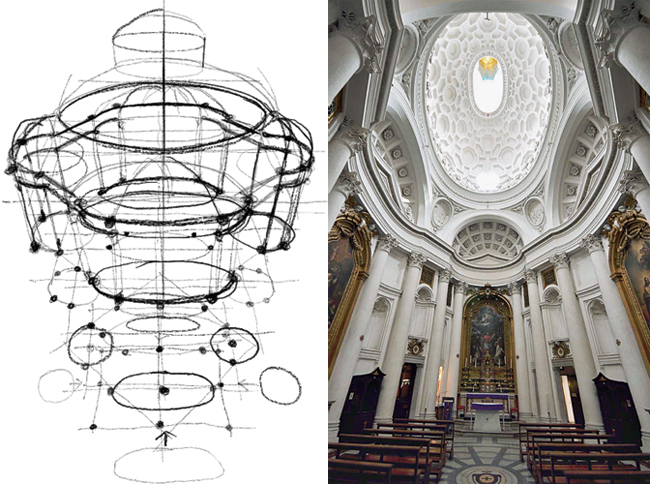The Afterlife of Drawing

The Afterlife of Drawing
Massimo Scolari’s fantastical compositions, like the oil painting Gate for a Maritime City, are remarkable for their almost-obsessive detail, not because they depict buildable form.
Image ' Massimo Scolari

The Afterlife of Drawing
Greg Lynn sketches by hand, but typically after first digitally modeling an idea. In his drawing of the Ravioli Chair, designed for Vitra, he describes form with a gridlike mesh.
Images © Greg Lynn FORM

The Afterlife of Drawing
“Mental Canvas” is a conceptual-design tool that allows users to combine several 2-D drawings and then explore the assembled sketches by panning, tilting, and zooming. The program’s development team used it to analyze San Carlo alle Quattro Fontane, a 17th-century church by Francesco Borromini, in Rome.
Drawing © Soo-Hyun Kim, Yale University

The Afterlife of Drawing
As part of her design process, Marion Weiss, of Weiss/Manfredi, moves back and forth between hand sketches, digital tools, and physical models. Drawings for the firm’s student center at Barnard College, which is clad in acid-etched glass, included a set of charcoal facade studies.
Image © Weiss/Manfredi




But with the increasing sophistication of digital tools for modeling, parametric design, and rendering, is drawing by hand destined to become a lost art? That was the question posed by Is Drawing Dead?, a recent symposium at the Yale School of Architecture which attracted more than 450 attendees with a roster of speakers that included Archigram founder Peter Cook, Zaha Hadid Architects director Patrik Schumacher, and Andrew Witt, director of research at Gehry Technologies.
Despite its provocative title, the February 9'11 conference was “not intended to be a sentimental homage to hand drawing,” according to Victor Agran, a lecturer at the school. The goal was to combat “a loss of visual literacy” in academia and in the profession, said Agran, who organized the event with fellow faculty member George Knight.
A few of the symposium’s presenters feared hand drawing was especially vulnerable in the face of proliferating digital tools. Finnish architect Juhani Pallasmaa, for instance, made the case for sketching as a tactile tool for discovery. While drawing, an architect isn’t focused on the individual lines he or she is creating, but is instead “occupying that space, as if touching all its surfaces,” said Pallasmaa. Such a kinesthetic connection is “difficult, if not impossible, to simulate with computers,” he said.
Although such an impassioned defense implies an adversarial relationship between drawing and software, sketching still plays a vital role, even in some of the most technologically advanced practices. For example, the digital design and fabrication pioneer Greg Lynn draws by hand, but often after first quickly modeling an idea with the computer. Sketching, for Lynn, is a method for clarifying ideas, he explained at Yale’s event. Curiously, his hand drawings sometimes mimic computer graphic techniques: In a sketch of the Ravioli Chair designed for Vitra, Lynn defines the shape of its upholstery-covered plastic shell with gridlike contours, much in the same way 3-D modeling software does.
Design is an iterative process, and many architects move back and forth between digital and hand-drawn modes of representation and exploration as a project progresses. Marion Weiss, principal of Weiss/Manfredi, provided glimpses of such a design process as part of her Is Drawing Dead? presentation. Among the drawings she showed was a series of charcoal sketches produced at various points in the development of a scheme for the Diana Center at Barnard College, including a set of facade studies. For Weiss, discoveries made while drawing, and the choice of the sketching medium, helped guide decision making. At Barnard, the selection of acid-etched glass cladding panels was an attempt to maintain a “whisper of the charcoal” in the completed building, she said.
Like many other firms, Weiss/Manfredi relies heavily on model building as part of its design process. “Analog, digital, and physical studies form an important triad,” said Weiss, with each medium having its own advantages, but also limits.
One of the undeniable advantages of digital tools is that they allow the quick examination of a space or object from multiple vantage points. However, most 3-D programs require the specification of a well-defined geometry, making them cumbersome for conceptual-design exploration. But a computer graphics system that combines digital tools’ dynamic visualization capabilities and the spontaneity associated with hand sketching could be commercially available within the next year. As part of the drawing conference, Julie Dorsey, a Yale professor of computer science, demonstrated “Mental Canvas”—the program she is developing with a team of researchers from several universities.
The program promises to allow users to create 2-D sketches on a pressure-sensitive tablet, position them on virtual planar surfaces, and then combine the drawings in 3-D. According to Dorsey, designers will be able to easily adapt and refine their sketches, but also explore the spatial and volumetric implications of the assembled drawings through panning, tilting, and zooming.
In architectural schools, there is greater emphasis than ever on digital tools. For example, at Columbia University’s Graduate School of Architecture and Planning (GSAP), former dean Bernard Tschumi took the radical step of creating so-called “paperless studios” in the mid-1990s. Now, however, the computer is “just a given,” noted Laura Kurgan, associate professor and director of visual studies. In the first semester’s required drawing and representation course, graduate architecture students are introduced to modeling, while in the second semester’s course they study the relationship of hand drawing and digital design. But by the time students graduate from the GSAP program, they have command of between 12 and 15 types of software, estimated Kurgan.
Increasingly, students like those at Columbia and digitally savvy practitioners are actively modifying the tools created for them by software developers. Architects are writing their own scripts within programs like Rhino and Maya as a way of loosening often-hidden constraints that can restrict the creative process. “Software has built-in parameters that create invisible boundaries,” said Cammy Brothers, an architectural historian and associate professor at the University of Virginia. But by adapting the software, architects can gain a stronger command of these tools, taking control of them much in the same way they would manipulate a stick of charcoal, a pen, or a pencil. “You can make a computer as open as a pencil,” said Brothers, “but you have to push at it.”










